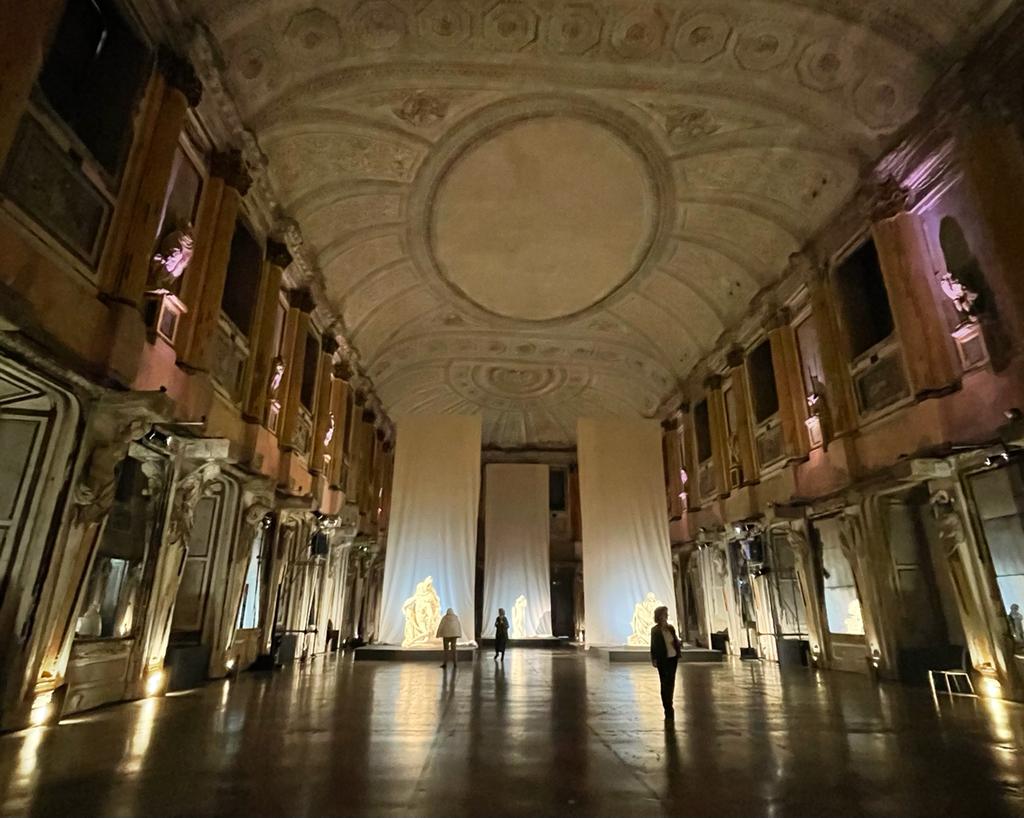Le tre Pietà di Michelangelo ( the three Pietà by Michelangelo) is extraordinarily resurrected in a magnificent and thrilling setting created by Massimo Chimenti, from October 22 to January 8, 2023, in Sala delle Cariatidi of Palazzo Reale (Palazzo Reale, n.d.). This exhibition was the result of collaboration between the municipalities of Milan, Florence, and the Vatican Museums will allow visitors to understand Michelangelo’s creativity and artistic talent through an examination of three casts from the 19th and 20th centuries. It is the perfect continuation of the art show that ended to great acclaim at the Museo dell’Opera del Duomo in Florence.
The presentation was outstanding as it stood in front of the background to the Pietà will consist of three large sheets that will span the full height of the room and have a significant visual impact. It enhanced their robust artistic value and the religious sentiment Michael Angelo expressed at three distinct stages of his life. They were Pietà of St. Peter of the Vatican City, Pietà of Santa Maria del Fiore (i.e., Pietà Bandini), and Pietà Rondanini (Palazzo Realle, n.d.). He started his work with the grandiose early work with a classicist imprint, to the unfinished sculpture of his last days. Over sixty years separate the first Pietà, the Vatican, from the last, the Rondanini.

Ulderico Grispigni resurrected the Pietà of St. Peter of the Vatican City’s cast in 1975 in the Calchi and Plaster Laboratory of the Vatican Museums (Devreux, 2014). The event for its creation came at a crucial time for the Pietà or after the statue was vandalized in 1972, necessitating a new cast. The Pietà Bandini, also known as the Pietà of Santa Maria del Fiore in Florence, was cast in 1882 and is credited to Florentine coach Oronzo Lelli (Devreux, 2014). It is currently housed in possession of the Florentine Gipsoteca of the Porta Romana Institute of Art. The Pietà Rondanini cast in 1953 has been conserved in the Castello Sforzesco since 1952. It is currently housed in the vaults of the Museum of Ancient Art, where it is now on exhibit following rigorous restoration (Museo Pieta Rondanini – Michaelangelo, n.d.)
Michelangelo put his hand to the Vatican once in 1498, just twenty years old, involved a contract that explicitly required “a Virgin Mary clothed with dead Christ, naked in her arms” (Palazzo Real, n.d., para. 9) . The sculpture releases a grandiloquent, perfect beauty, in line with the first production of the Tuscan master. Concerning the face of the Virgin Mary, considered by some to be too young, the artist defended himself at the time, stating that purity and holiness preserve youth and beauty. His youthful production is flanked by his mature age, which sees Michelangelo greatly changed as a man and as an artist, in crisis to the point of wanting to abandon sculpture, his reason for living until then. The sentiment that dominates these works is different; the style becomes less redundant considering the human destiny of suffering, death, and resurrection.
The sentimental touch was presented at the Bandini Pietà, sculpted between 1547 and 1555 (Trehern, 2016). At that time, Michelangelo Buonarroti was already an older man who often meditated on faith, the passion of Christ, and his subsequent death. The history of this Pietà is long and tormented. The marble, full of impurities and too hard, did not allow Michelangelo to complete the work and led the artist to break a limb of Christ and, subsequently, to hammer the statue by breaking it in several places.
The last treasure he left to us was Pieta Rondanini; Michelangelo worked on this marble until shortly before his death. In the “sublime unfinished” of the Tuscan artist, finished parts alternate with parts that are not finished or not worked at all, in a statuary composition that – in the words of Luigi Serenthà – is capable of involving us in the unstoppable movement of the body of the dead Christ inside the body of the Mother.
The exhibition itinerary aims to focus precisely on this in the eyes of visitors, namely the maturing of the feelings of one of the greatest geniuses in the history of art, showing how the same drama can achieve such different results in the hands of an artist immersed in time and the becoming of inspiration. This exhibition created a visual story capable of presenting episodes from recent history with Michelangelo’s sculptures as protagonists. As a young man, Michelangelo created the Vatican Pietà, sculpting the so-called Pietà Bandini of Santa Maria del Fiore in Florence, and the Pietà Rondanini of the Castello Sforzesco in Milan. These examples tell of the sensitivity reached by the Tuscan genius throughout his long life.
References:
Devreux, G., Badaloni, P., Di Pinto, R., Federici, V., Felice, A., Santamaria, U., Zander, P., Gabrielli, N., & Morresi, F. (n.d.). St. peter’s pieta: History and restoration 40years later. Vatican Printing Press. Retrieved November 214AD, from https://www.eriercd.org/images/sections/news/pdf/PietaRestoration.pdf
Museo Pieta Rondanini – Michaelangelo. (n.d.). On the trail of the pieta. Castello Sforzesco. https://rondanini.milanocastello.it/en/content/trail-pietà
Palazzo Realle. (n.d.). Le Pietà di Michelangelo. https://www.palazzorealemilano.it/mostre/tre-calchi-storici-la-sala-delle-cariatidi
Treherne, M. (2016, December 5). Forms of Faith in Sixteenth-Century Italy. Routledge. ISBN 9781351936163







